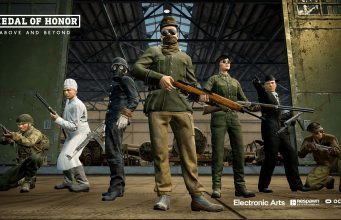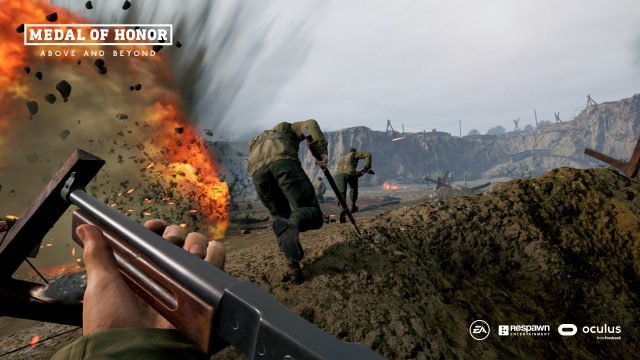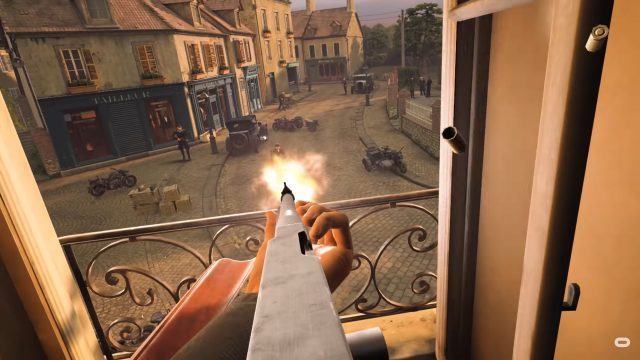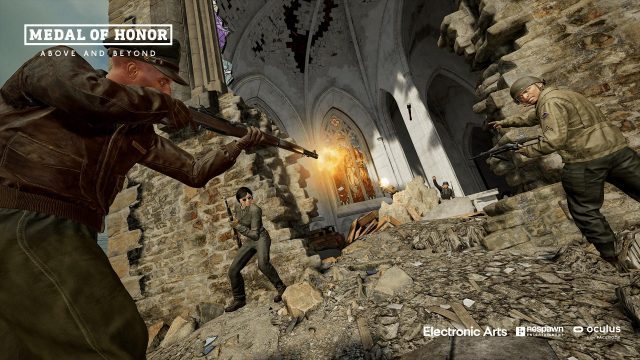
Medal of Honor: Above and Beyond, the next big Oculus Studios title, launches in just a few days. We’ve spent several hours with the campaign and multiplayer components of the game ahead of launch and are here to share our initial impressions.
As both an Oculus Studios title and a game developed by Respawn Entertainment—known for Titanfall, Apex Legends, and Star Wars Jedi: Fallen Order—anticipation for the game is understandably high for what has been pitched as a significant VR production by a AAA studio.
Despite the years of production and AAA pedigree, however, several hours of Medal of Honor: Above and Beyond have so far left me with a feeling that the game is poorly paced, lacking in mechanical polish, and not quite capitalizing on the unique potential of VR.
Campaign

I still have a large portion of the game to complete—and my preview here is only allowed to cover the first two (of five total) missions—so my thoughts could well change in the later stages, but the game’s opening hasn’t left a strong impression.
While the game is supposed to be an action-packed and somewhat authentic WWII adventure, Medal of Honor: Above and Beyond feels like it isn’t sure what kind of tone it’s aiming for. If an intense adventure is the goal, the cheesy, stilted dialogue and often poorly animated characters are seriously detracting from being lost in that fantasy.
The game’s choppy pacing hasn’t helped either. The opening missions of the game feel like vignettes the player is dragged through that amount to little more than brief shooting galleries where every enemy is dispatched with the same simple point-and-shoot strategy no matter which gun you’re using. The environments have so far felt more like backgrounds than unique arenas.
While there’s a few interesting touches to the weapons—like the lever-action rifle which is cocked with a satisfying gesture—the system by which the player interacts with weapons and objects often impacts immersion and makes for janky moments in gameplay.
One core issue is how item selection and gripping is handled. Rather than grabbing the item closest to your hand, the game sometimes seems to have a mind of its own when it comes to object selection.
After struggling to understand exactly how the object selection worked, I found an option which turns on a visual indicator that draws faint lines out of your hands to show where you’re actually ‘pointing’. While this made it easier to understand how the game was making its choice, it didn’t make things much more intuitive, and I continued to often grab the wrong thing at the wrong time. This was especially annoying when trying to grab a grenade from my chest but my hand would inexplicably grab the handle of my gun even though it was much further away.
Weapons strike a reasonably good balance of interesting reloading interactions while being quick and easy enough to keep combat moving quickly. But weapons follow different rules than ‘normal’ objects in the game, and can only be held in the hand assigned in the settings. This leads to funky moments where you might like to pull a gun out with your off-hand to quickly use it, but instead your hand automatically grabs the grip (instead of trigger/handle) and it can’t be fired until your primary hand plugs into its assigned slot on the trigger.
The way that the position of your hands influences the position of the weapons is inconsistent and strange at times, like with the sawed-off shotgun which is fully controlled by the position of your main-hand, even when you’re holding the weapon with both hands.
The result of these sorts of unpolished interactions is that Medal of Honor: Above and Beyond feels—at least this far into the game—like it’s stuck in the 2017 era of VR gameplay. It doesn’t feel like it’s backed by an understanding of the best VR interaction and gameplay practices that have been evolving over the last few years, nor does it feel like it’s showcasing many unique ideas of its own.

Again, my preview is limited to the game’s opening missions, and I still have more of the game to complete before our full review which will be published soon. So it’s possible that there will be something entirely unexpected that really changes the feel of the game, but this is where my impressions stand for now.
Multiplayer

Medal of Honor: Above and Beyond’s multiplayer brings a Call of Duty level of speed, finesse, and occasional frustration to VR.
Call of Duty is known for its frenetic pace and low ‘time-to-kill’, where individual gunfights are frequently decided by who saw who first. Above and Beyond feels in that very same vein.
While this can bring a sense of totally trouncing your opponents by killing them before they even have a chance to shoot, it also means you’ll often be on the receiving end—dying before you have a chance to react, which is no more fun in VR than it is outside of VR.
This is not helped by the fact that the game’s lever-action rifle is a one-hit kill which seems ripe for terrorizing players who won’t even get the benefit of hearing incoming fire before it’s too late.
The objective-based game modes bring much needed order to Above and Beyond’s battlefield, which helps somewhat alleviate the ‘I saw you first so I win’ issue. Objectives being in static locations make it clearer where enemies might be coming from, so you’re less likely to get caught off guard than in the deathmatch modes where someone might have spawned just around the corner from you.
There is some fun to be had in Above and Beyond’s multiplayer if you like the run-and-gun gameplay. Fights aren’t particularly dynamic—as players are all just running and strafing around with joysticks with no climbing or other map interactivity—but at least the shooting feels tight and straight forward.

Above and Beyond brings at least one unique idea to multiplayer in the form of the ‘Mad Bomber’ game mode.
In this free-for-all mode, all players spawn with a timed explosive which they can hide pretty much anywhere on the map—on ceilings, under a table, behind a bookshelf, etc.
Once planted, the bomb starts ticking and will eventually explode and kill anyone nearby. The fun part is that other players can disarm your explosive for extra points if they can find it in time (by listening to where the ticking sound is coming from), otherwise you’ll get points when your bomb explodes (and extra points if it kills anyone when it goes off).
The mode plays out like a series of miniature hide-and-seek moments and opens the door to creative strategies. While you could, of course, find an obscure corner of the map to hide your bomb and wait for it to explode, it might be better to hide it in a high-traffic area of the map to use as a trap to lure unsuspecting players into your sights.
This is not only interesting because of the strategies that emerge from the hide-and-seek bomb mechanic, but especially because it takes advantage of VR both in the way you can intricately place the bomb almost anywhere you want, and how positional audio is used during your frantic search for an enemy’s bomb.
When it comes to weapons in multiplayer, the game offers minimal loadout options. You’ll get to pick one primary weapon plus your choice of extra grenades or extra syringes. You can also pick up an extra primary weapon from a downed opponent. Loadouts can be changed between deaths.
There’s a scoped sniper-rifle among the primary weapons, but it feels largely unusable due to a poorly implemented face-scope which blacks out your non-dominant eye and all peripheral vision. The face-scope seems to want to aggressively attach to your face if the gun comes anywhere close, which prevents holding the weapon in a ‘ready’ position to quickly acquire targets. The image through the scope not only lags significantly as you move the gun about, but also seems to blow out the image contrast in certain occasions, making it difficult to see your target.
Outside of the Mad Bomber mode, the low TTK and not particularly dynamic gunfights make it difficult to say if Above and Beyond’s multiplayer will feel fresh, fun, and replayable in the long term but I’d say there’s at least a shot of the game finding a core following which enjoys the run and gun approach.
The post ‘Medal of Honor: Above and Beyond’ – Campaign & Multiplayer Preview appeared first on Road to VR.
Ream more: https://www.roadtovr.com/medal-of-honor-above-and-beyond-preview-campaign-multiplayer/
No comments:
Post a Comment